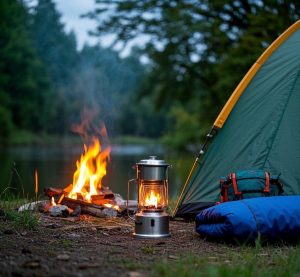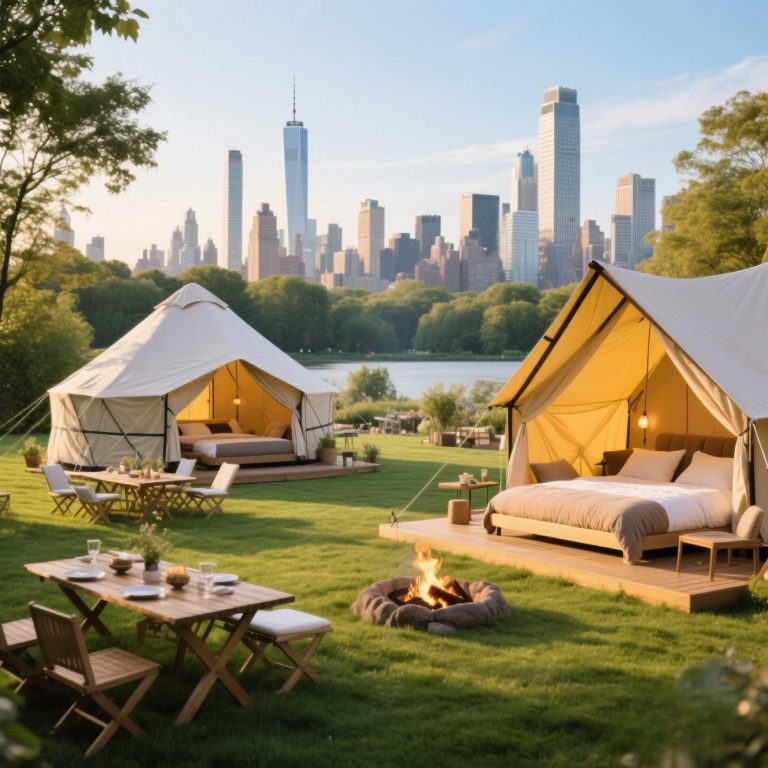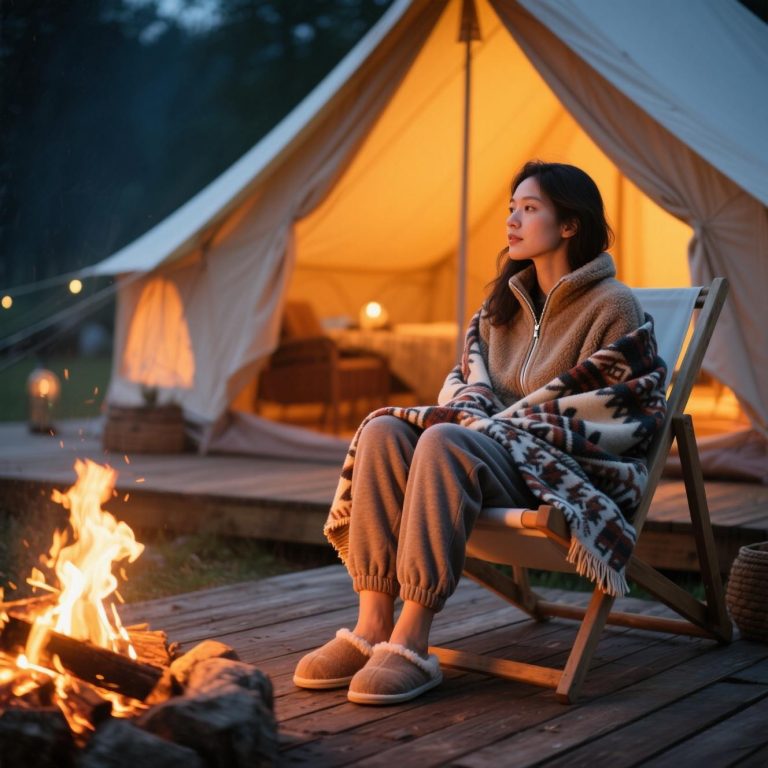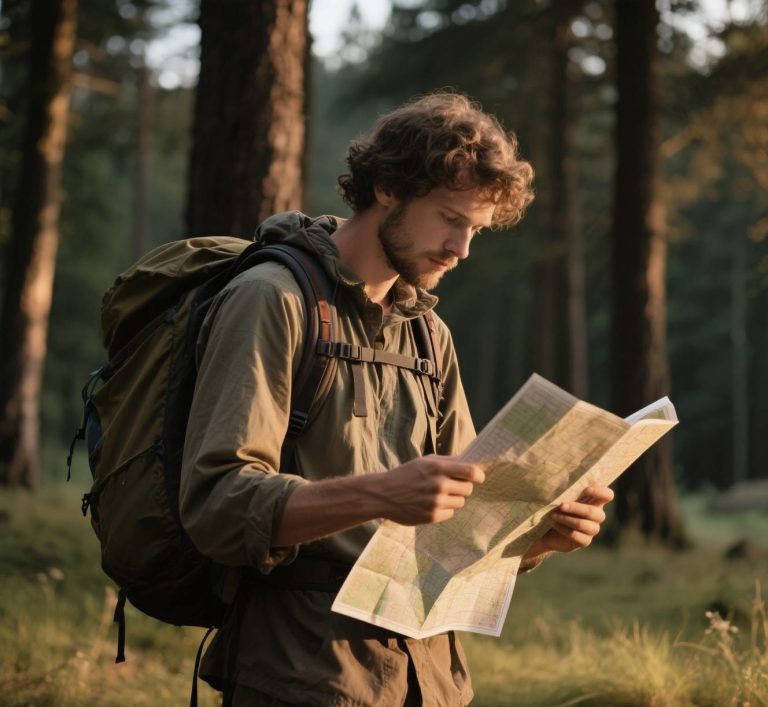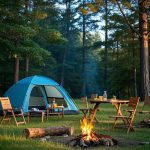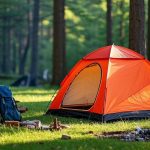Camping for beginners can be a thrilling and rewarding experience. Whether you’re conducting a weekend getaway or a longer adventure, understanding the essentials of camping is crucial for ensuring a successful trip.
This camping for beginners guide covers gear, meals, safety, and campsite tips—everything you need for a fun and successful first camping trip.
Disclosure: This post contains affiliate links. As an Amazon Associate, We earn from qualifying purchases.

Table of Contents
A. Why Start Camping? The Life-Changing Benefits
I wanted to tell you something – my first time camping as a beginner was a complete disaster. Picture this: I showed up with a $15 tent from the discount store, zero clue how to start a fire, and somehow managed to set up camp directly over an ant hill. By morning, I was covered in bug bites, hadn’t slept more than two hours, and was pretty sure outdoor life wasn’t for me.
Despite the chaos of that first camping for beginners experience, I realized that camping offered unique lessons that couldn’t be learned elsewhere. It was a journey of discovery that allowed me to grow and learn as a person.
Embracing outdoor adventures is essential for all camping for beginners. Research shows that spending time in nature reduces cortisol levels and fosters mental well-being.
For beginners, physical health improvements are also notable. You can easily rack up steps by exploring and enjoying the outdoors.
Throughout my camping journey, the skills I developed taught me invaluable lessons in resilience and adaptability.
But something weird happened on that miserable drive home. I kept thinking about those few moments when I actually got the fire going, watching the flames dance while the sun set behind the trees. That feeling of accomplishment, even after such a rough night, stuck with me.
When planning your own camping trip, focus on essential gear and preparation methods to ensure a seamless experience. This camping for beginners guide will help you.
Mental Health Benefits: Harvard Health research shows that spending just 20 minutes in nature connection can reduce your body’s stress hormones and promote relaxation. After a weekend camping trip, I come home feeling like I’ve hit a mental reset button. The constant noise from social media, work emails, and daily stress just disappears out there.
Physical Health Improvements: Your Fitbit will love camping days – I regularly hit 15,000+ steps compared to my usual office-bound 4,000. Setting up camp, gathering firewood, and hiking to water sources keep you moving without feeling like exercise.
Skill Development: The problem-solving skills you develop are incredible. When your camp stove won’t light at 7 PM and you’re hungry, you figure it out fast. These moments teach resilience that no self-help book can match.
B. Types of Camping: Finding Your Style
Before diving into gear, let’s talk about different camping styles. This affects everything from what you pack to where you go.
1. Car Camping (Perfect for Beginners)
You park right next to your campsite and can bring whatever fits in your vehicle. This is where I recommend everyone starts because you can pack extra comfort items and bail out easily if things go wrong.
Best for: First-timers, families with kids, people who want an outdoor experience with amenities nearby.

2. Backpacking/Backcountry Camping
Everything you need goes in your backpack. Weight and space become critical factors. Don’t even think about this until you’ve mastered car camping basics.
Best for: Experienced campers seeking solitude and adventure.
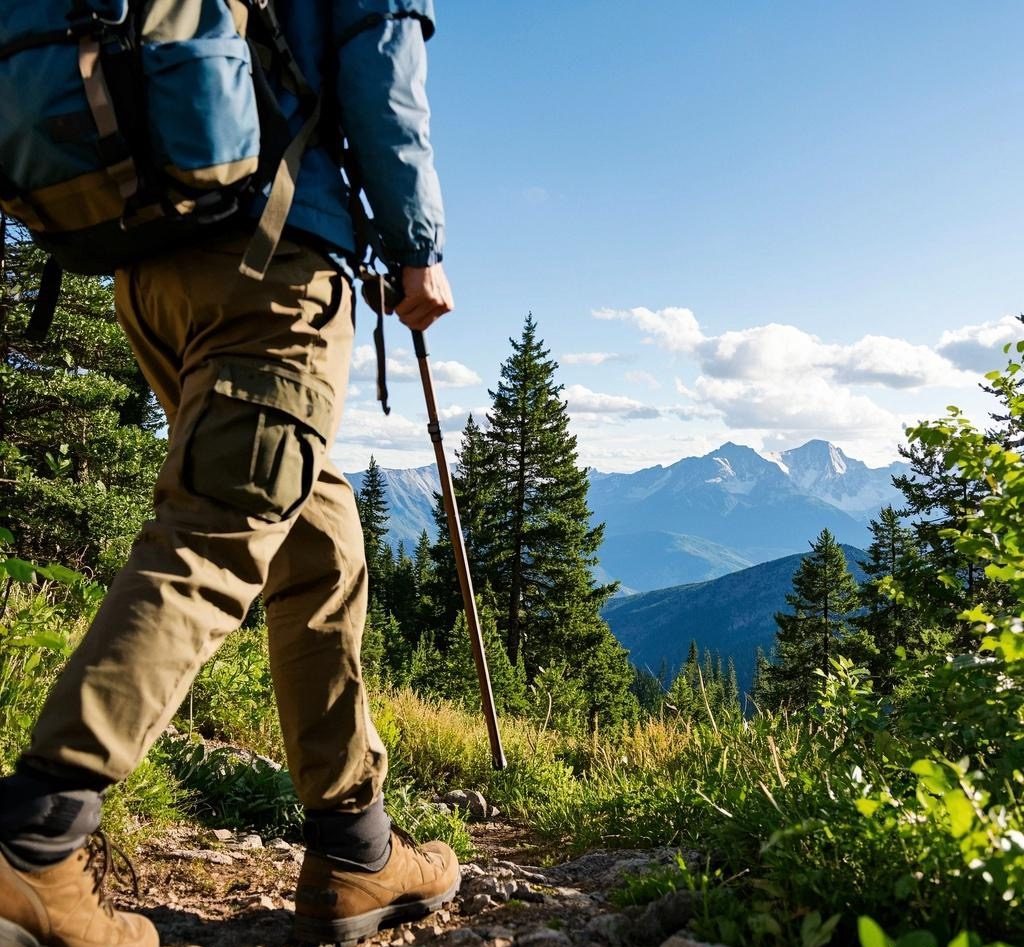
3. RV Camping
The luxury option with beds, kitchens, and bathrooms. Great for people with mobility issues or those who want nature with home comforts.
Best for: Families, seniors, or anyone wanting outdoor experiences without roughing it.

C. Essential Camping Gear and Packing

Let me save you from the epic fails I made during my early camping days. After years of trial and error, here’s what actually matters – starting with the four gear essentials that can make or break your trip.
1. The Big Four: Shelter, Sleep, Storage, Light
Tent Selection Guide: For beginners, go with a 3-season tent rated for one more person than you actually need. So if you’re camping solo, get a 2-person tent. The extra space is a game-changer for gear storage.
Budget Option: Coleman Sundome 4-Person Tent ($60-80)
- Easy setup with color-coded poles
- Full rainfly protection
- Decent vestibule space
Mid-Range: REI Co-op Base Camp 4 ($200-250)
- Superior weather protection
- More durable materials
- Better ventilation system
Premium: Big Agnes Copper Spur HV UL4 ($400-500)
- Ultralight for backpacking
- Excellent build quality
- Multiple door options
Sleeping System Essentials: Your sleeping bag’s temperature rating should be 10-15 degrees lower than the coldest temperature you expect. So if it might hit 40°F, get a 25°F bag.
Sleeping Bags:
- Budget: Coleman Brazos ($30-40) – Good for summer camping above 30°F
- Mid-Range: Kelty Cosmic 20 ($160-180) – Versatile 3-season option
- Premium: Western Mountaineering UltraLite ($600-700) – Ultralight down fill
Sleeping Pads: Even a basic closed-cell foam pad makes a massive difference. I learned this while sleeping directly on rocky ground in Colorado.
- Foam Pad: Therm-a-Rest Z Lite Sol ($45-50)
- Inflatable: Klymit Static V ($30-40)
- Luxury: Therm-a-Rest NeoAir XTherm ($240 -270)
Lighting Systems: This is the fourth essential that can make or break your camping experience. Setting up camp in the dark because you forgot proper lighting? Been there, done that, never again.
Headlamps (Your Primary Light Source): Headlamps beat flashlights every time because you need both hands free for camp setup, cooking, and everything else.
- Budget: Petzl Tikka ($34) – 350 lumens, solid reliability
- Mid-Range: Black Diamond Spot 400 ($49) – Great beam distance, waterproof
- Premium: Petzl Actik Core ($87.95) – Rechargeable battery, multiple light modes
Backup Lighting (Always Have Redundancy):
- Small LED flashlight for emergencies
- Battery-powered lantern for camp area lighting
- Extra batteries (more than you think you need)
Pro Lighting Tips:
- Red light mode preserves night vision
- Test all lights before leaving home
- Pack batteries separately to prevent accidental drain
- Bring a small lantern for inside your tent – way better than holding a flashlight in your mouth while looking for stuff
Cooking and Food Storage
- Canister Stove: Jetboil Flash ($139.07) – Fast, efficient, beginner-friendly
- Liquid Fuel: MSR WhisperLite ($159.95) – Better in cold weather
- Budget: Coleman Classic Propane Stove ($45) – Great for car camping
Camp Stoves:
Lighting systems play a crucial role when camping for beginners, making it vital to prepare accordingly.
Cookware Basics:
- Lightweight pot set
- Spork or camping utensils
- Can opener/multi-tool
- Cooler (for car camping)
- Bear canister or rope for food storage
2. Additional: Lighting and Navigation
Beyond Your Primary Headlamp: We covered headlamps in the Big Four, but here’s additional lighting gear that makes camp life easier.
Area Lighting:
- Coleman Battery Lantern ($41.60) – Great for cooking and hanging out
- String LED lights ($19.99) – Creates awesome camp ambiance
- Solar lanterns ($15.99)- Environmentally friendly but less reliable
3. Complete Gear Checklist
Shelter & Sleep:
- Tent with footprint
- Sleeping bag
- Sleeping pad
- Pillow (inflatable saves space)
Cooking & Food:
- Stove and fuel
- Cookware and utensils
- Cooler and ice (car camping)
- Water bottles/hydration system
- Water purification method
Clothing & Personal:
- Weather-appropriate clothing layers
- Rain gear
- Extra socks and underwear
- Toiletries and medications
Tools & Safety:
- First aid kit
- Multi-tool or knife
- Rope/paracord
- Duct tape
- Emergency whistle
5. Camping Clothing Guide: What to Wear and Pack
This is where people mess up most. I packed three pairs of jeans for my first trip because apparently, I thought I was going to a denim convention. Cotton kills when it gets wet and cold.
The Layering System
Base Layer (Next to Skin):
- Merino wool or synthetic materials only
- Avoid cotton at all costs
- Pack: 2-3 shirts, 3 pairs of underwear, 3 pairs of socks
Insulation Layer:
- Fleece jacket or down vest
- Keeps warmth even when damp
- Easy to pack and unpack as temperatures change
Shell Layer:
- Waterproof, breathable rain jacket
- Wind protection
- Critical for unexpected weather
Specific Clothing Recommendations
Summer Camping (Above 50°F):
- Lightweight hiking pants (not jeans!)
- Moisture-wicking t-shirts
- One warm layer for evening
- Rain jacket
- Hat and sunglasses
Spring/Fall Camping (30-60°F):
- Insulating layers become critical
- Warm hat and gloves
- Extra socks (your feet get cold first)
- Waterproof boots
Winter Camping (Below 32°F): Don’t attempt this as a beginner. Seriously.
Footwear Strategy
Hiking Boots vs Trail Runners: Unless you’re carrying heavy loads or have ankle issues, trail runners are often more comfortable and dry faster.
Recommended Options:
- Budget: Merrell Moab 3 ($103 – 140$)
- Trail Runners: Salomon X Ultra 3 ($124)
- Heavy Duty: Danner Mountain 600 ($200)
Camp Shoes: Bring something comfortable to slip on around camp. Crocs, sandals, or slip-on shoes work great.
D. Camping Food and Meal Planning
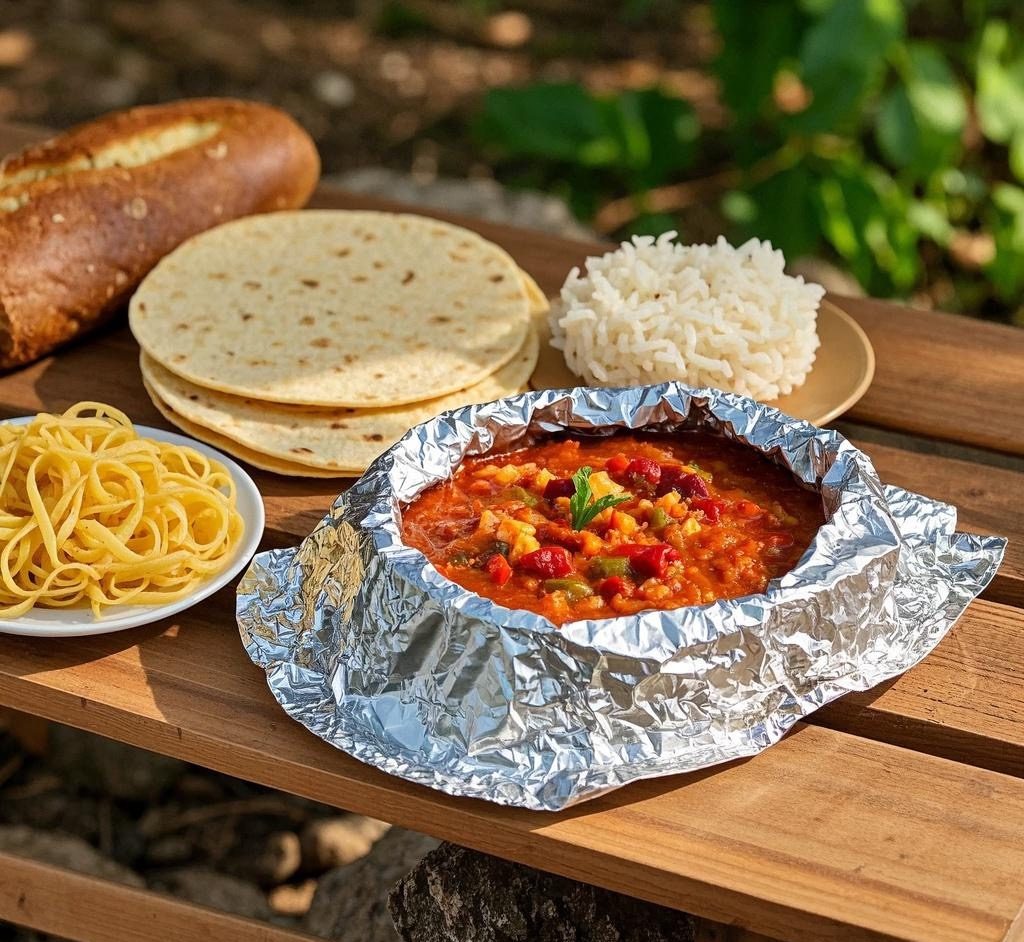
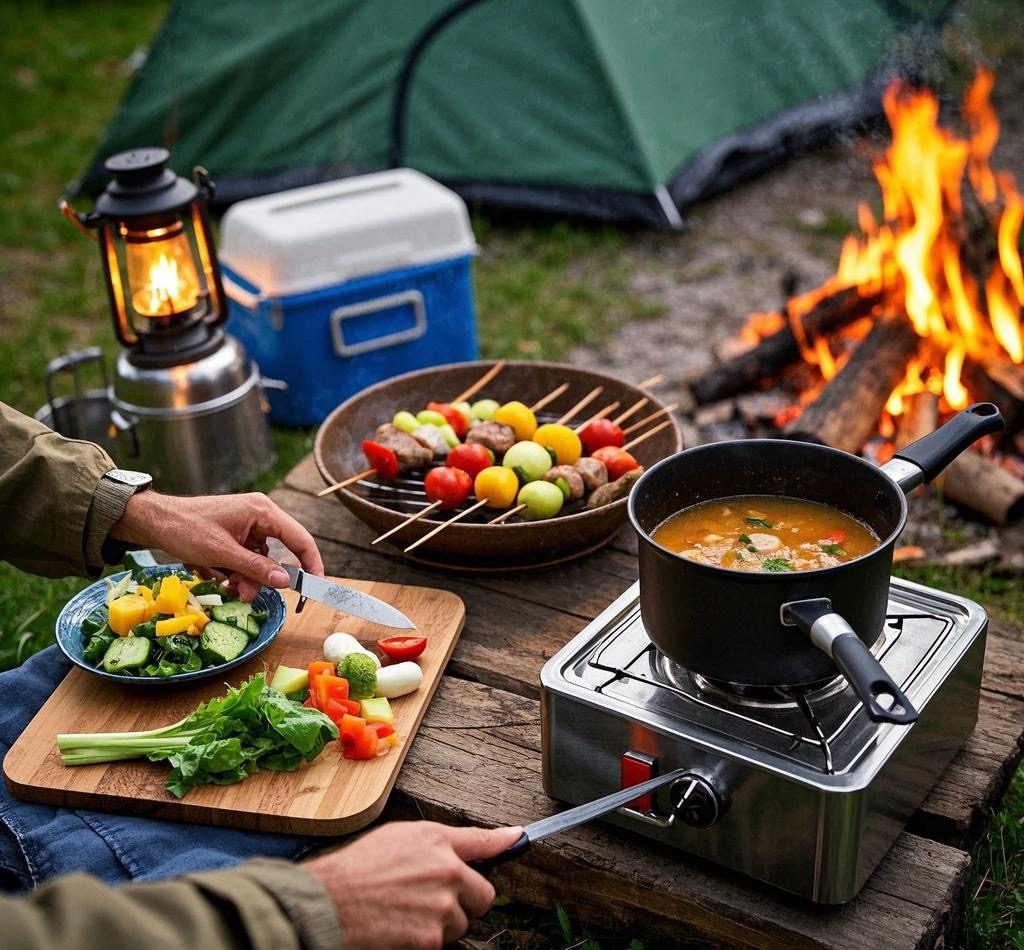
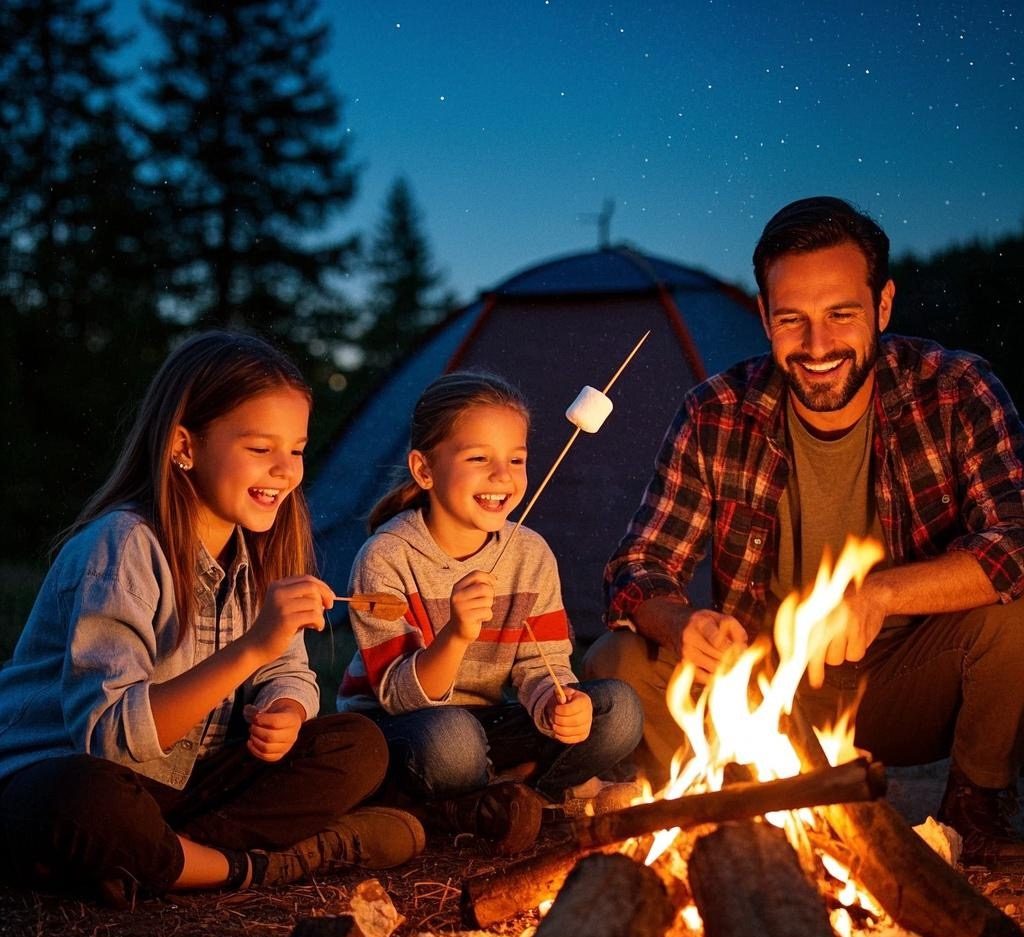
Forget the fancy camping recipes you see on Instagram. Start simple and build up your skills. My go-to beginner meal plan actually works in real conditions.
1. The KISS Principle (Keep It Simple, Stupid)
As you embark on your first camping trip, remember that food storage and preparation are key to a successful trip.
Day 1 Dinner – One-Pot Wonder:
- Pre-made chili in a foil pouch
- Instant rice or pasta
- Tortillas or bread
- Total cook time: 10 minutes
Breakfast – Quick Energy:
- Instant oatmeal with dried fruit and nuts
- Coffee or hot chocolate
- Granola bars
- Cook time: 5 minutes
Lunch – No-Cook Options:
- Peanut butter and jelly sandwiches
- Trail mix
- Fresh fruit (apples travel well)
- Jerky or dried meat
2. Advanced Meal Ideas (Once You’re Comfortable)
Foil Packet Dinners: Wrap meat, vegetables, and seasonings in heavy-duty foil. Cook directly on coals for 15-20 minutes.
One-Skillet Breakfast: Scrambled eggs with pre-cooked bacon or sausage, and add some cheese.
Campfire Desserts: S’mores are classic, but try banana boats (banana stuffed with chocolate chips, wrapped in foil).
To expand your outdoor cooking skills, explore trusted resources like Fresh Off The Grid for creative camp recipes, The Roving Foleys for family-friendly meal ideas, and Camping for Foodies for gourmet wilderness cuisine. These reputable sources offer everything from simple one-pot meals to elaborate outdoor feasts, helping you transform basic camping food into memorable dining experiences under the stars.
3. Water and Hydration
How Much Water to Bring: The standard is one gallon per person per day, but I always pack 50% extra. Dehydration ruins everything.
Water Sources and Purification:
- Bring water from home for your first trips
- Natural sources need purification
- Water purification tablets: Aquatabs ($10.99)
- Filters: Sawyer Mini ($16.99) or LifeStraw ($14.95)
- Boiling: 3 minutes at sea level, 5 minutes above 6,500 feet
4. Food Storage and Safety
Car Camping: Good cooler with plenty of ice. Keep raw meat separate and maintain temperatures below 40°F.
Backcountry: Bear canisters in bear country, or hang food at least 12 feet high and 6 feet from tree trunks.
General Food Safety:
- Cook the meat to the proper temperature
- Don’t leave perishables in the danger zone (40-140°F) for more than 2 hours
- When in doubt, throw it out
E. Personal Care and Toiletries
This is where beginners either overpack completely or forget essentials. Here’s what actually matters based on years of trial and error.
1. Essential Toiletries Checklist
Daily Hygiene:
- Biodegradable soap (Dr. Bronner’s works for everything)
- Toothbrush and toothpaste
- Deodorant
- Toilet paper in a ziplock bag
- Hand sanitizer
- Quick-dry towel
Personal Medications:
- Prescription medications (with extras)
- Pain relievers (ibuprofen/acetaminophen)
- Antihistamine for allergies
- Personal feminine hygiene products
Outdoor-Specific Items:
- Sunscreen (SPF 30+)
- Insect repellent (DEET or Picaridin-based)
- Lip balm with SPF
- Baby wipes (camper’s best friend)
2. Bathroom Etiquette and Leave No Trace
Using Established Facilities: Always use provided restrooms when available. Keep them clean for the next person.
Backcountry Bathroom Protocol:
- Dig catholes 6-8 inches deep, 200 feet from water sources
- Pack out toilet paper and hygiene products
- Use biodegradable soap at least 200 feet from water
Personal Hygiene Without Showers: Baby wipes and dry shampoo become your best friends. Focus on face, hands, feet, and underarms for quick freshening up.
F. Planning Your First Trip: A 7-Day Countdown
Location can make or break your first camping experience. Start easy and work your way up to more challenging spots.
1. Types of Campgrounds
State Parks (My Top Recommendation for Beginners):
- Well-maintained facilities
- Restrooms and potable water
- Reasonable fees ($15-35/night)
- Usually not too crowded
- Good balance of amenities and nature
National Parks:
- Incredible scenery, but often crowded
- Reservations are required well in advance
- More expensive ($25-50/night)
- Strict rules and regulations
National Forest Campgrounds:
- More primitive but authentic feel
- Cheaper ($10-25/night)
- First-come, first-served is often available
- Less crowded than national parks
Private Campgrounds (KOA, etc.):
- Most amenities, but it can feel like an outdoor hotel
- Good for families with young kids
- Often have pools, playgrounds, and camp stores
- More expensive but very beginner-friendly
2. Reservation Strategies
A key tip in any beginners guide to camping: always plan and secure reservations before your trip, as walk-in sites are often unavailable during busy seasons.
Book Early: Popular spots fill up 6 months in advance. Use Recreation.gov for federal sites, and ReserveAmerica for state parks.
Backup Plans: Always have 2-3 alternative campgrounds in mind. Weather or site availability can change quickly.
Useful Apps:
- Campendium: Reviews and photos from real campers
- iOverlander: Great for finding free camping spots
- AllStays: Comprehensive campground database
3. What to Look for in a Campsite
For Car Camping:
- Level ground for your tent
- Access to restrooms and water
- Some shade during hot weather
- Protection from wind
- Proper food storage facilities
Red Flags to Avoid:
- Sites in low areas that could flood
- Too close to busy roads or train tracks
- Areas with lots of dead trees (widow makers)
- Sites without any wind protection
2. Planning Your First Trip: 7-Day Countdown
Here’s your step-by-step timeline for a successful first camping trip.
One Week Before
Day 7:
- Confirm campground reservation
- Check the weather forecast
- Create a packing checklist
- Test all gear at home
Day 6:
- Shop for food and supplies
- Charge all electronic devices
- Download offline maps
- Prepare emergency contact list
Mid-Week Preparation
Embrace the adventure of camping for beginners and discover how rewarding it can be.
Day 5:
- Check vehicle condition (oil, tires, etc.)
- Pack non-perishable food items
- Organize gear by category
- Review campground rules and amenities
In your search for appealing locations, remember that the right camping for beginners spot can set the tone for your adventure.
Day 4:
- Pack clothing and personal items
- Prepare a first aid kit
- Check fire restrictions
- Confirm departure time with camping partners
Your first camping sites are pivotal experiences that will shape your future camping for beginners outings.
Final Preparations
Day 3:
- Pack a cooler with ice and perishables
- Load camping gear in the vehicle
- Double-check reservation details
- Set up automatic email/text replies
Day 2:
- Final weather check
- Backup plan review
- Pack snacks and water for travel
- Early bedtime for good rest
Day 1 – Departure Day:
- Final gear check
- Share the itinerary with the emergency contact
- Leave with plenty of time
- Have fun and stay flexible!
Quick Setup Guide for Camp
Arrival Priorities:
- Check in and locate your site
- Set up the tent while you have good light
- Organize gear and set up the kitchen area
- Locate restrooms and water sources
- Plan your evening meal and activities
G. Safety and Emergency Preparedness
I learned most of these lessons the hard way. Don’t be like me – be prepared from day one.
1. Pre-Trip Planning
Weather Monitoring: Check forecasts obsessively and have a backup plan. I’ve had to pack up and leave early because of unexpected storms, and that’s totally okay.
Emergency Contacts:
- Local ranger station phone number
- Emergency services (911 works in most areas)
- Park/campground office
- Poison control: 1-800-222-1222
2. Essential Safety Gear
Here’s the essential safety gear list every camping for beginners guide should include; these basics can be lifesavers on your first outdoor adventure.
First Aid Kit Contents:
- Adhesive bandages (various sizes)
- Gauze pads and medical tape
- Antiseptic wipes or solution
- Pain relievers (ibuprofen, acetaminophen)
- Antihistamine for allergic reactions
- Thermometer
- Tweezers for splinter removal
- Emergency blanket
- Personal medications
Emergency Signaling:
- Whistle (three sharp blasts are a universal distress signal)
- Mirror for signaling aircraft
- Bright colored bandana
- Cell phone with portable charger
- Emergency beacon (for remote areas)
3. Common Camping Hazards
Every camping for beginners guide should cover common hazards like wildlife encounters, weather changes, and fire safety—because knowing these risks before your first trip can mean the difference between a great adventure and a dangerous situation.
Wildlife Encounters:
- Store food properly
- Never feed wild animals
- Make noise while hiking
- Know what to do for local wildlife (bears, snakes, etc.)
Weather Dangers:
- Lightning: Avoid tall objects and metal
- Hypothermia: Stay dry and warm
- Heat exhaustion: Stay hydrated and seek shade
- Flash floods: Never camp in washes or low areas
Fire Safety:
- Check fire restrictions before your trip
- Keep water nearby when having a fire
- Completely extinguish fires before leaving
- Never leave a fire unattended
H. Budget-Friendly Camping Tips
Here are some budget-friendly camping tips for beginners: You don’t need to spend thousands to start camping. Here’s how to get started without breaking the bank.
1. Gear on a Budget
Buy, Borrow, or Rent Strategy:
- Borrow expensive items first (tent, sleeping bags)
- Rent from outdoor stores to try before buying
- Buy basics new (clothing, personal items)
- Shop end-of-season sales
Best Places for Cheap Gear:
- Facebook Marketplace and Craigslist
- REI Garage Sales (returned/damaged items)
- End-of-season clearance sales
- Military surplus stores
- Thrift shops for clothing layers
DIY Alternatives:
- Use old blankets instead of expensive sleeping bags for summer car camping
- Mason jars work great for camp lighting with battery-powered LED strings
- Milk jugs make excellent water storage containers
- Duct tape fixes almost everything
2. Campground Cost-Saving Tips
Free Camping Options:
- National Forest dispersed camping
- Bureau of Land Management (BLM) areas
- Some Walmart parking lots allow overnight parking
- Apps like Campendium help find free spots
Off-Season Camping: Spring and fall often have lower rates and fewer crowds. Just pack appropriate gear for cooler weather.
Group Camping: Split costs with friends or family. Many campgrounds offer group sites that are cheaper per person.
3. Common Beginner Mistakes to Avoid
Learn from my failures so you don’t have to repeat them.
1. Gear Mistakes
Overpacking: My first trip, I brought enough gear for a month-long expedition. You don’t need five different knives or backup gear for your backup gear.
Underpacking Critical Items: But don’t forget essentials like rain gear, extra socks, or a first aid kit.
Cotton Clothing: I cannot stress this enough – cotton kills when it gets wet and cold. Invest in synthetic or wool base layers.
Cheap Tent Regret: That $15 tent I mentioned earlier? It leaked, had zippers that jammed, and fell apart after three trips. Sometimes it’s worth spending a bit more.
2. Planning Mistakes
Overambitious First Trips: Start with car camping at established campgrounds within an hour of home. If something goes wrong, you can always bail out.
Not Checking Weather: Always have contingency plans for bad weather. Pack extra tarps and know where to go if storms hit.
Poor Campsite Selection: Avoid low areas that could flood, spots under dead trees, or places too close to bathrooms (trust me on this one).
3. Food and Water Mistakes
Forgetting Can Opener: Bring a manual can opener or stick to pull-top cans.
Not Enough Water: Better to bring too much than run out. Dehydration makes everything harder.
Complicated Meal Plans: Keep it simple for your first few trips. Master basic camp cooking before attempting gourmet meals.
Be sure to know what to look for in a campsite to make your camping for beginners experience enjoyable and safe.
I. Seasonal Camping Considerations
Each season brings unique challenges and rewards. Here’s what you need to know.
As you plan, consider reservation strategies to secure your camping for beginners site early.
1. Spring Camping (March-May)
What to Expect:
- Variable weather conditions
- Possible rain and mud
- Fewer crowds
- Beautiful wildflowers
Special Considerations:
- Pack extra layers for temperature swings
- Waterproof everything
- Check for seasonal campground closures
- Bug season starts in late spring
2. Summer Camping (June-August)
Benefits:
- Predictable weather
- Long daylight hours
- All facilities open
- Great for beginners
Challenges:
- Crowds and higher prices
- Heat during midday
- Thunderstorms possible
Tips:
- Book reservations well in advance
- Plan activities early morning and evening
- Bring plenty of water and shade
3. Fall Camping (September-November)
Why Fall is Amazing:
- Beautiful foliage
- Cooler temperatures
- Fewer bugs
- Less crowded
Considerations:
- The weather can change quickly
- Some facilities may close early
- Days get shorter fast
- Pack warm layers for cold nights
4. Winter Camping
For Beginners: Don’t. Seriously, winter camping requires specialized gear and experience. Wait until you’ve mastered three-season camping.
J. Leave No Trace Principles
The 7 Leave No Trace Principles offer a simple guide to minimizing your impact outdoors. They apply everywhere—from backyards to wilderness—and evolve with new research to stay current and effective. These aren’t just suggestions – they’re essential for keeping our outdoor spaces beautiful for future campers.
The Seven Principles
When it comes to bathroom etiquette, camping for beginners requires understanding established protocols to maintain cleanliness.
- Plan Ahead and Prepare
- Know regulations and special concerns
- Travel in small groups
- Bring appropriate gear
- Travel and Camp on Durable Surfaces
- Use established campsites
- Walk on trails, not vegetation
- Keep campsites small
- Dispose of Waste Properly
- Pack out all trash
- Dispose of human waste in catholes 6-8 inches deep
- Pack out the toilet paper
- Leave What You Find
- Don’t take rocks, plants, or artifacts
- Leave natural and cultural objects as you find them
- Minimize Campfire Impacts
- Use established fire rings
- Burn only small, dead wood
- Extinguish fires completely
- Respect Wildlife
- Store food securely
- Never feed animals
- Observe from a distance
- Be Considerate of Other Visitors
- Keep noise levels down
- Respect other campers’ space
- Control pets
The best camping experiences come when we follow Leave No Trace principles—packing out every piece of trash, extinguishing our fires completely, and leaving our campsite better than we found it—preserving the magic of wild places so that future campers can experience the same untouched beauty that first called us to sleep under the stars.
Conclusion: Your Camping Journey Starts Now
That first disastrous camping trip I mentioned at the beginning? It taught me that outdoor adventures aren’t about having perfect gear or flawless execution. They’re about stepping outside your comfort zone, learning new skills, and connecting with nature in ways that screen time just can’t match.
The confidence you’ll gain extends far beyond the campsite. After you’ve successfully navigated setting up shelter, cooking meals over an open fire, and handling unexpected weather, office challenges start feeling pretty manageable. Camping taught me that I’m more capable than I ever imagined.
Start small, learn constantly, and don’t be afraid to make mistakes. Every experienced camper has stories about gear failures, getting lost, or sleeping through their tent collapsing in the wind. Those become the best stories later.
Your first trip won’t be perfect, and that’s exactly how it should be. Pack this camping for beginners guide, choose an easy campground close to home, and take that first step into a hobby that might just change how you see both nature and yourself.
The wilderness is waiting. Your adventure starts now.
Remember: This guide covers the basics, but every camping trip is different. Stay flexible, use common sense, and prioritize safety above all else. Happy camping!
